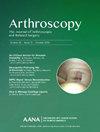Concomitant Biceps Tenodesis Does Not Compromise Arthroscopic Rotator Cuff Repair Outcomes
IF 4.4
1区 医学
Q1 ORTHOPEDICS
Arthroscopy-The Journal of Arthroscopic and Related Surgery
Pub Date : 2024-10-01
DOI:10.1016/j.arthro.2024.02.035
引用次数: 0
Abstract
Purpose
To compare outcomes of patients who underwent rotator cuff repair (RCR) with concomitant biceps tenodesis with those who underwent an isolated RCR.
Methods
Exclusion criteria included previous ipsilateral shoulder surgery, irreparable rotator cuff tears, rotator cuff arthropathy, calcific tendinitis, adhesive capsulitis requiring a capsular release, or advanced osteoarthritis of the glenohumeral joint. Patients were indicated for biceps tenodesis if they had any degree of tendon tearing, moderate-to-severe tenosynovitis, instability, or a significant degenerative SLAP tear. Primary outcome measures included American Shoulder and Elbow Surgeons score, Simple Shoulder Test, EuroQoL 5-Dimension 5-Level visual analog scale, EuroQoL 5-Dimension 5-Level, and a site-specific questionnaire, which focused on surgical expectations, satisfaction, and complications. Multivariate analysis of variance to analyze descriptive statistics and determine significant differences between the patient groups for subjective and objective outcome measures were performed.
Results
There were no significant differences for pain/visual analog scale (0.34 ± 0.09 vs 0.47 ± 0.09, P = .31), American Shoulder and Elbow Surgeons score (96.69 ± 0.87 vs 94.44 ± 0.91, P = .07), and Simple Shoulder Test (11.42 ± 0.17 vs 10.95 ± 0.18, P = .06) between the RCR with concomitant biceps tenodesis and isolated RCR at a minimum of 2 years’ postoperatively. This is despite the RCR with concomitant biceps tenodesis group having significantly larger rotator cuff tears (4.25 ± 0.30 cm2 vs 2.80 ± 0.32 cm2, P = .001) than the isolated RCR group.
Conclusions
This study revealed that concomitant biceps tenodesis does not compromise outcomes when compared with an isolated RCR at 2-year follow-up, despite this group having larger rotator cuff tears.
Level of Evidence
Level III, retrospective case study.
同时进行肱二头肌腱膜切除术不会影响肩袖修复的效果
目的:本研究旨在比较接受肩袖修复术(RCR)并同时接受肱二头肌腱膜切除术的患者与接受孤立肩袖修复术的患者的治疗效果:排除标准包括曾接受同侧肩部手术、肩袖撕裂无法修复、肩袖关节病、钙化性肌腱炎、需要关节囊松解的粘连性关节囊炎或盂肱关节晚期骨关节炎。如果患者有任何程度的肌腱撕裂、中度至重度腱鞘炎、不稳定或明显的退行性 SLAP 撕裂,则应进行肱二头肌腱鞘切除术。主要结果测量指标包括美国肩肘外科医生学会评分(ASES)、简单肩关节测试(SST)、EQ-5D-5L VAS、EQ-5D-5L 和针对特定部位的调查问卷,其中重点关注手术预期、满意度和并发症。研究人员进行了多变量方差分析,以分析描述性统计数字,并确定患者组之间在主观和客观结果测量方面的显著差异:结果:RC-BT 组和 RC 组在术后至少 2 年的疼痛/VAS(0.34 ± 0.09 vs. 0.47 ± 0.09,p = 0.31)、ASES(96.69 ± 0.87 vs. 94.44 ± 0.91,p = 0.07)和 SST(11.42 ± 0.17 vs. 10.95 ± 0.18,p = 0.06)方面没有明显差异。尽管 RC-BT 组的肩袖撕裂面积(4.25 ± 0.30 cm2 vs. 2.80 ± 0.32 cm2,p = 0.001)明显大于孤立的 RCR 组,但结果仍是如此:本研究表明,与孤立的RCR相比,同时进行肱二头肌腱膜切除术不会影响2年随访的结果,尽管该组肩袖撕裂面积更大:证据级别:III级,回顾性病例研究。
本文章由计算机程序翻译,如有差异,请以英文原文为准。
求助全文
约1分钟内获得全文
求助全文
来源期刊
CiteScore
9.30
自引率
17.00%
发文量
555
审稿时长
58 days
期刊介绍:
Nowhere is minimally invasive surgery explained better than in Arthroscopy, the leading peer-reviewed journal in the field. Every issue enables you to put into perspective the usefulness of the various emerging arthroscopic techniques. The advantages and disadvantages of these methods -- along with their applications in various situations -- are discussed in relation to their efficiency, efficacy and cost benefit. As a special incentive, paid subscribers also receive access to the journal expanded website.

 求助内容:
求助内容: 应助结果提醒方式:
应助结果提醒方式:


